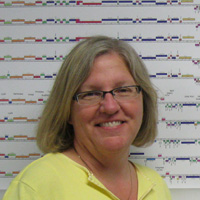Welcome to the forums at seaphages.org. Please feel free to ask any questions related to the SEA-PHAGES program. Any logged-in user may post new topics and reply to existing topics. If you'd like to see a new forum created, please contact us using our form or email us at info@seaphages.org.
Recent Activity
All posts created by debbie
| Link to this post | posted 27 Aug, 2018 18:56 | |
|---|---|
|
|
Kayla, Would you do dilutions of D29 and not just a single spot? You streak from P1FF streak from stock #2 looks like smeg. When you see 4 day colonies, are they dry and wrinkled? (as in, not smooth and glistening?) |
| Link to this post | posted 23 Aug, 2018 19:59 | |
|---|---|
|
|
Be careful! The auto-annotation predicts forward strand proteins in the middle of the genome. The proteins in the reverse strand are better supported. |
| Link to this post | posted 23 Aug, 2018 14:38 | |
|---|---|
|
|
At this time (8-23-18 ), we felt it prudent to call the DNA binding proteins around the integrases "helix-turn-helix DNA binding proteins", even thought 2 of them are hitting Lambda's CI. (Genome used in this evaluation are Nandita and Ryan). |
| Link to this post | posted 23 Aug, 2018 14:35 | |
|---|---|
|
|
Cluster F genomes have 2 tyrosine integrases. |
Posted in: Cluster FF Annotation Tips → 2 integrases
| Link to this post | posted 23 Aug, 2018 14:33 | |
|---|---|
|
|
Corgi gp19 and 20 HHPred hit the same domain of the crystal structure of Mycobacteriophage Pukovinik (gp37) excise. Call this a helix-turn-helix DNA binding protein because that is the domain that it hits. |
| Link to this post | posted 23 Aug, 2018 14:29 | |
|---|---|
|
|
The 4 genes between capsid and tape measure (Corgi gp 8-11) include (in this order) head-to-tail adaptor, head-to-tail stopper, major tail, hypothetical protein. the hypothetical protein in these genomes hits HK97 gp10. Bob Duda of the Hendrix lab (who extensively has studied the structural genes of HK97) agrees the function of this gene, though structural, is unknown. |
| Link to this post | posted 23 Aug, 2018 14:26 | |
|---|---|
|
|
No tail assembly chaperones have been found….yet. |
Posted in: Cluster FE Annotation Tips → No tail assembly chaperone
| Link to this post | posted 23 Aug, 2018 14:24 | |
|---|---|
|
|
The cpapsid is fused to the capsid maturation protease (gp7 in Corgi). |
Posted in: Cluster FE Annotation Tips → capsid and protease fusion
| Link to this post | posted 22 Aug, 2018 16:01 | |
|---|---|
|
|
This cluster has 2 tyrosine integrases. |
Posted in: Cluster AY Annotation Tips → Two integrases
| Link to this post | posted 22 Aug, 2018 15:56 | |
|---|---|
|
|
The 6 genomes that we reviewed today *Auxilium, Hestia, Richie, SeaHorse, Faja, and Isolde all have a small terminase subunit. The large terminase subunit, except for Hestia, is split into 2 gene products: "terminase, large subunit (ATPase domain)" and "terminase, large subunit (nulcease domain)". |
Posted in: Cluster AY Annotation Tips → Large terminase in two pieces

